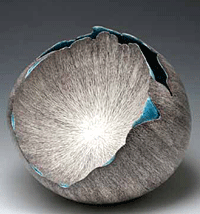![]()
Curator's Statement:

This exhibition presents the work of twenty-eight Japanese ceramic artists. The work is functional, from vases and platters, to abstract sculptures. Skillful and mindful expression is evident in the artists' craftsmanship.
These works present highly sophisticated artistic skills. In addition to the presentation of the artist's craftsmanship, "skillful" describes the artist's attitude toward the process of creating art. It is a sense of discipline in the tradition of the Japanese culture. These artists often see development of their skills as training for the cultivation of humanity: psychological development. This is called Tao/Dō, which means a path to the maturity of humanity. The examples are in the fields of art, such as: Ka-Dō (flower arrangement), Sa-Dō (Japanese tea ceremony), Ken-Dō (Japanese fencing) and Ju-Dō (Japanese marshal arts). In this tradition, ceramic artists practice as apprentices with a master. The practice is not limited to learning technique, but also represents the search for meaning in the creation of the artwork. In modern times, this apprenticeship process is not practiced in many places, but its spirit still remains in the field of ceramics. Thus, skillful means both the outcomes of a high level of craftsmanship and the process of mental development as an artist/human.
Mindful expression is a unique aspect of ceramics. All ceramic works are completed through firing in a kiln. In the kiln, the character of clay transforms from soft to hard (mature). Without firing, clay forms will not become artwork. The firing process is beyond the control of the artist. The completion of the artwork is the gift of firing. The modern technology of gas and electric kilns has made it easier for ceramic artists to control aspects of the firing process for consistency. But, the results of firing remain unpredictable. Especially in wood firing (using wood as fuel and stoking the fire in the kiln for 3-7 days, 24 hours per day), the results are different each time. The artist will not get the same result ever again. In this process, a certain sense of humbleness develops toward creating the artwork. Even when an artist creates artwork with perfection, the whole effort could be in vain after the piece is fired. The only thing the ceramic artist can do is to accept the firing results without aversion. Because of this uncontrollable phase in the ceramics process, the artist's mind experiences a sense of egoless expression. As a result, artists appreciate the gift of firing and develop a sense of awe for nature, which is beyond human control. This does not mean that artists give up their effort and rely solely on the gift of firing. The attitude for creating art is, "Do your best and leave to the rest to firing/nature," or, "Do your best and leave the rest to your fate."
In viewing this exhibition, I would like the observer to see the ceramic works of art while focusing on these two key approaches to expression: skillful and mindful. Additionally, I ask the viewer to see that many works here are container forms even though some of them have sculptural form. What do you add to the container form? With a vase, imagine your floral arrangement. The sculptural form of the vase is completed with the flowers. With a platter, what food would you serve and how would you place the food on the platter? The platter shows its beauty when combined with the food. What do you feel from abstract sculpture? As you open your imagination, these works of art show their beauty. While the art pieces have highly sophisticated beauty by themselves, they represent another realm of beauty when your mind opens to imagination.
Finally, I would like to share a comment from Shiho Kanzaki, a Japanese ceramic artist, regarding the meaning of skillful and mindful expression. (His documentary film is showing in the back of the art gallery during this exhibition.) He has this to say of his wood firing process:
"At loading time, I place everything the way it should be. If a piece falls by accident and it becomes a nice piece, it is good, because it happened naturally. But next time, if we place it that way to reproduce the effect, it's not natural; it's artificial. It becomes 'indecent'. Any kind of artificial manipulation, like placing things in such a way just because it will be beautiful, I am not interested. To see the difference between what is natural and what is not should be the point."
Acknowledgements:
I extend my special thanks and gratitude to the collector, Mr. William Bayer, for his generosity in lending his collection to the exhibition, without which this show would not be possible. His collections perfectly support my intent for this exhibition. Also, I would like to thank Michael Garcia for his beautiful posters, exhibition cards and banners. Special thanks go to Renata Breth, Robert F. Agrella Art Gallery Director, Caren Caterall, , Eva Banister and students (Rachel Perry and Tania Fitzsimmons) for their assistance in installing these pieces.
Curator:
Hiroshi Fuchigami,
Instructor of Ceramics